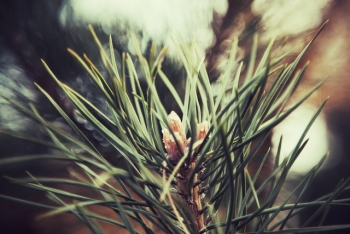The Pine Trees of Washington State

Pine trees are members of the Pinaceae family and Pinus genus. Over 100 different species of pine trees can be found throughout North America, Central America, South America and Canada, as well as Europe, the Mediterranean and Asia.
In the state of Washington, native pine trees include the Western White pine (Pinus monticola), Whitebark Pine (Pinus albicaulis), Ponderosa Pine (Pinus ponderosa) and the Lodgepole Pine (Pinus contorta).
The Western White Pine grows up to 160 feet and has pale brown, soft, finely grained wood. The tree’s blue green needles grow in clusters of five up to four inches long. These big trees have a long and slender cone that can grow up to 15 inches in length. The tree, which is found at elevations from sea level to 7,000 feet, prefers moist, rich soil.
Whitebark Pine, also referred to as the Scrub Pine, Creeping Pine and Pitch Pine, is found in high elevations and can grow to almost 90 feet in height. The tree’s needles appear in clusters of five, and it’s cone ranges in size from approximately 2.5 inches to over 4.5 inches long. The Whitebark Pine can have a shrub-like appearance. Its shape can also be impacted by the wind.
The Ponderosa Pine, also known as the western yellow pine, yellow pine, bull pine and blackjack pine, has soft fine-grained dark brown to reddish-brown wood. The Ponderosa can reach heights of over 200 feet. Its dark yellow-green needles grow in clusters up to 11 inches long and its cones grow up to 6 inches long. Ponderosa pines can be found in many large gardens and parks.
Lodgepole Pines inhabit mountain regions and coastal regions. The Lodgepole can grow as either a shrub or tree. Various subspecies are used in landscaping and gardens. The tree requires full sunlight for growth and does best in moist, well-drained sandy soils. Its needles grow in clusters up to 3 inches in length.
Non-native pines that do well in this region include the Pinus Flexilis “Cesarini Blue” and the Vanderwolf Pine. They are used in landscaping, gardening and as privacy trees. The Cesarini Blue requires full sun and can be kept small and dense with regular pruning. Asymmetrical in appearance, it can grow up to 14 feet in height with a 7 foot spread.
The Vanderwolf Pine, known for its pyramid shape and soft blue-green needles that appear to glow in the sun, grows up to 30 feet in height with a 15 foot spread. The Vanderwolf does well in full sun but can also tolerate partial shade.
If you are considering buying evergreen trees for privacy screening, a pine such as a Pinus Flexilis “Cesarini Blue” or Vanderwolf Pine might be a good choice. Before choosing a tree, get advice from a big trees expert from a reputable tree arborist about which would be the best trees to transplant for your location and soil.
Do you need to remove a pine tree from your property? A big trees specialist can explain your options, including having the tree “rescued” by doing a tree transplant for free.
